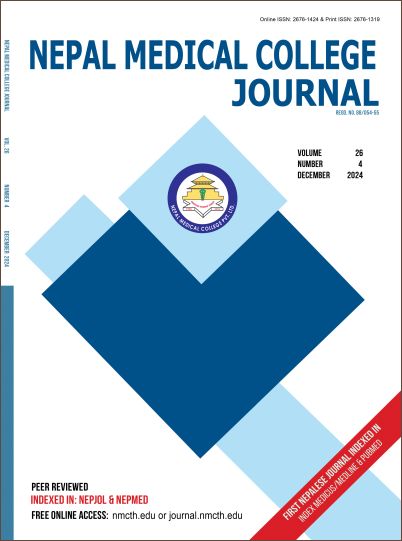Association between Shape of Sella Turcica and Class of Malocclusion
DOI:
https://doi.org/10.3126/nmcj.v26i4.74474Keywords:
Morphology, sella turcica, malocclusion, lateral cephalogram, orthodontic diagnosisAbstract
The sella turcica, a saddle-shaped depression in the sphenoid bone, houses the pituitary gland and shares a common embryonic origin with teeth and facial structures, making it a valuable tool in orthodontic diagnosis and treatment planning. This study aims to analyse the association between sella turcica morphology and malocclusion using lateral cephalograms. A hospital-based cross-sectional study was conducted at the Department of Orthodontics, Mahatma Gandhi Dental College and Hospital, Jaipur, India. A total of 137 pre-treatment lateral cephalograms of patients aged 10 to 30 years were included in the study. The morphology of the sella turcica was assessed using Axelsson’s classification, and malocclusion was categorized using Angle’s classification. Statistical analysis was performed using descriptive statistics and the chi-square test, with SPSS version 27. Among the 137 cephalograms analysed, the normal shape of the Sella turcica was the most prevalent (n=55), followed by pyramidal (n=30) and oblique (n=20) shapes. Bridging (n=6) and irregular (n=12) shapes were the least observed. The results suggest an association between certain Sella turcica shapes and specific types of malocclusions. The findings of this study highlight the potential of lateral cephalograms for early diagnosis and intervention in patients with malocclusion, especially in cases with abnormal Sella turcica morphology. Identifying such associations could aid in improving orthodontic treatment outcomes.
Downloads
Downloads
Published
How to Cite
Issue
Section
License
Copyright (c) 2024 Nepal Medical College Journal

This work is licensed under a Creative Commons Attribution 4.0 International License.
This license enables reusers to distribute, remix, adapt, and build upon the material in any medium or format, so long as attribution is given to the creator. The license allows for commercial use.




